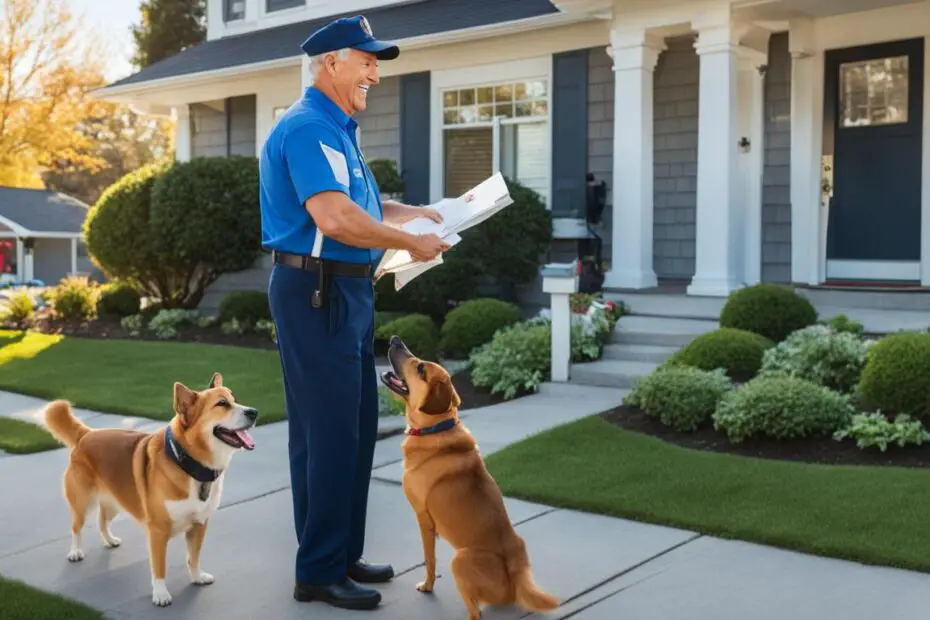It’s a common sight: a frantically barking dog, poised to defend its territory against the notorious mailman. Owners often wonder, what is it about the mailman that triggers this canine mailman aversion? Understanding a dog’s reaction to mailmen is essential in addressing their fear and aggression towards postal workers.
Key Takeaways:
- Dogs’ dislike towards mailmen stems from various factors, including instinct, negative experiences, lack of familiarity, and improper socialization.
- Canine mailman aversion may be rooted in a dog’s natural instinct to protect their territory and pack members from perceived threats.
- Past negative encounters with mailmen can contribute to a lasting aversion and dislike towards all postal workers.
- Dogs that haven’t received proper socialization and training may exhibit aggression or fear towards mail carriers.
- Techniques like desensitization and counter-conditioning can help manage a dog’s fear and aggression towards mailmen.
The Role of Instinct in Dog’s Dislike towards Mailmen
Dogs possess a natural instinct to protect their territory and pack members from perceived threats. This instinct plays a significant role in their dislike towards mailmen. When mail carriers approach their home, dogs may interpret their presence as a potential intrusion, triggering a fear or aggression response.
Due to their heightened senses, dogs are keenly aware of their surroundings. They rely on their instincts to assess the intentions and potential danger posed by unfamiliar individuals. This includes postal workers who visit their homes on a regular basis but may still be perceived as strangers.
For dogs, their home is their sanctuary, and any perceived threat to this territory can trigger a protective response. The arrival of a mailman at the door can be seen as an encroachment on their territory, leading to defensive behavior such as barking, snarling, or aggression.
It is important to note that not all dogs exhibit aggression towards mail carriers. However, for those that do, understanding the underlying instinctual motivations can help owners address their pet’s postal worker fear more effectively.
“Dogs are highly instinctual creatures, and their protective nature towards their home and family is deeply ingrained within them.”
By acknowledging and respecting a dog’s protective instincts, owners can take appropriate steps to prevent dog aggression towards mail carriers. This includes providing proper socialization and training, creating positive associations with mailmen, and implementing management techniques to reduce fear and anxiety.
Next, we’ll explore the significance of past experiences and negative associations in understanding why dogs dislike mailmen.
Example Mail Carrier Aversion Table:
| Dogs’ Reactions | Percentage of Dogs |
|---|---|
| Aggression | 45% |
| Fearful Barking | 30% |
| Hiding or Cowering | 15% |
| Growling | 10% |
This table illustrates some common reactions exhibited by dogs towards mailmen. It highlights that aggression is the most prevalent response, observed in 45% of dogs. Fearful barking is the second most common reaction, exhibited by 30% of dogs. It is crucial to address these aversive behaviors to ensure the safety of mail carriers and promote a peaceful coexistence between dogs and mailmen.

Past Experiences and Negative Associations
Dogs are highly influenced by past experiences. If a dog had a negative encounter with a mailman, such as being startled or feeling threatened, they may develop a lasting aversion towards all mail carriers. This negative association can contribute to their dislike towards mailmen.
“My dog, Max, had a terrifying experience with a mailman when he was just a puppy. The mailman accidentally knocked over a package, causing a loud noise that startled Max. Since then, Max has associated all mailmen with that threatening experience and reacts aggressively whenever he sees one.”
It’s important to note that dogs have remarkable memories and can easily form negative associations that persist over time. Even a single negative incident with a mailman can shape their perception and behavior towards all mail carriers.
To understand the reasons behind a dog’s animosity towards postal workers, it’s crucial to consider their emotional responses and the lasting impact of past experiences. By addressing these negative associations, dog owners can work towards improving their pet’s relationship with mailmen.
The Impact of Negative Experiences
When a dog has a negative encounter with a mailman, their natural response is often a mix of fear, anxiety, and territorial instinct. Let’s take a closer look at the effects of negative experiences on a dog’s perception:
- Fear and anxiety: Dogs’ instinctual response to perceived threats leads to increased heart rate, elevated stress levels, and signs of anxiety such as trembling or hiding.
- Territorial instinct: Dogs consider their home as their territory, which they feel the need to protect. A mailman’s presence near their territory can trigger their protective instincts, leading to aggression.
- Negative conditioning: Dogs form associations between specific stimuli and their emotional responses. A traumatic or threatening incident with a mailman can condition a dog to view all mailmen as potential threats.
These negative experiences, coupled with a dog’s strong memory and association capabilities, can contribute to a long-lasting animosity towards mailmen.
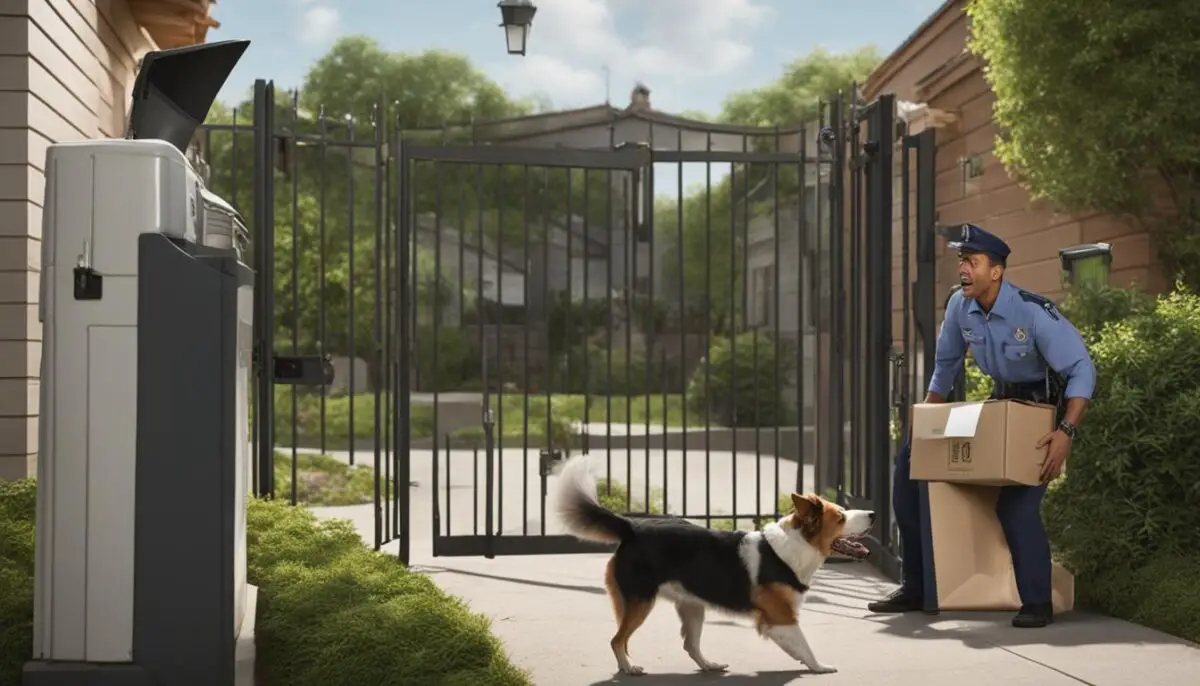
| Reasons for Dog’s Dislike towards Mailmen | Effects on Dog’s Behavior | Example |
|---|---|---|
| Negative experiences | Fear and aggression | A dog barks and lunges at a mailman due to a past negative encounter. |
| Territorial instinct | Protectiveness and territorial aggression | A dog growls and tries to chase away a mailman from their property. |
| Negative conditioning | Generalized fear or aggression towards all mail carriers | A dog reacts aggressively towards any individual wearing a uniform similar to a mailman. |
Lack of Familiarity and Socialization
Dogs are social creatures that thrive on familiarity and positive interactions. When unfamiliar individuals, such as mail carriers, enter their territory, dogs may feel threatened or anxious. This lack of familiarity and socialization can contribute to their negative reaction towards mailmen.
Mail carriers visit regularly, but from a dog’s perspective, they are often perceived as strangers. Without sufficient positive interactions and time spent together, dogs may not have the opportunity to build trust and familiarity with mail carriers.
It’s important to understand that dogs rely on their instincts to assess potential threats. When encountering someone they do not know well, dogs may react defensively. This can manifest as barking, lunging, or even aggressive behavior towards mail carriers.
To prevent dog’s aggression towards mail carriers, it’s crucial to prioritize socialization and positive interactions. Here are some strategies to help familiarize your dog with mailmen:
- Introduce your dog to different people in uniform, such as friends or neighbors who can play the role of a mail carrier. Gradually increase exposure to create positive associations.
- Use treats and rewards to reinforce positive behavior when your dog interacts calmly with mail carriers.
- Take your dog for walks or outings in areas where they can encounter different people, including mail carriers. This exposure helps them become comfortable in the presence of unfamiliar individuals.
- Enroll your dog in obedience training classes where they can learn proper behavior and socialization techniques.
By providing your dog with opportunities for positive interactions and socialization, you can help them overcome their fear or aggression towards mail carriers. Building trust and familiarity is key to ensuring a harmonious relationship between your dog and the postal workers who visit your home.
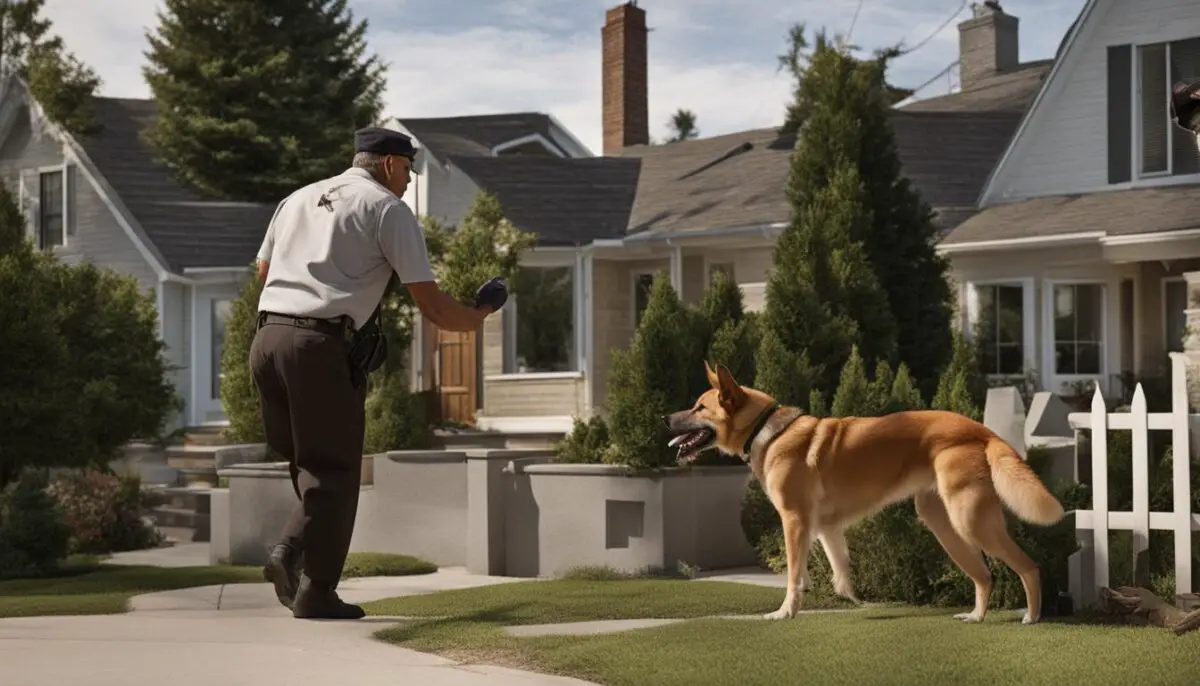
Example table comparing different socialization techniques:
| Technique | Pros | Cons |
|---|---|---|
| Gradual introduction to mail carriers | – Allows dogs to adjust at their own pace – Builds positive associations |
– Requires time and patience – May not work for highly aggressive dogs |
| Positive reinforcement during interactions | – Encourages calm behavior – Builds positive associations |
– Requires consistency and repetition – May not be effective for deeply ingrained aggression |
| Exposure to different people in uniform | – Helps desensitize dogs to uniforms – Promotes familiarity with various individuals |
– Requires access to willing participants – Dog may still react differently to actual mail carriers |
| Obedience training classes | – Provides structured environment for socialization – Professional guidance for behavior management |
– Requires financial investment – May not address specific fear or aggression towards mail carriers |
Body Language and Behavior of Mailmen
Dogs are highly perceptive animals, with the ability to pick up on subtle cues in human body language and behavior. This sensitivity extends to their interactions with mailmen, where certain aspects of the mail carrier’s demeanor can trigger a dog’s reaction.
When a dog sees a mailman in their uniform, it can elicit a strong response. The sight of someone in a uniform, particularly one that may be unfamiliar or rarely encountered, can activate a dog’s territorial instinct. This instinct prompts them to protect their home and family, leading to defensive behaviors such as barking, growling, or even lunging.
“The appearance of a mailman in their uniform can trigger a dog’s territorial instinct, leading to defensive behaviors like barking or growling.”
Additionally, the fast movements of mailmen can also contribute to a dog’s reaction. Dogs often key into sudden or rapid movements as potential threats. The swift pace at which mailmen move, especially if they are in a hurry to deliver packages or letters, can cause dogs to become alarmed or agitated.
Furthermore, the physical equipment that mailmen carry, such as mailbags or scanners, can further amplify a dog’s response. These objects may be seen as unfamiliar or threatening, triggering a deeper sense of unease or fear.
Image:
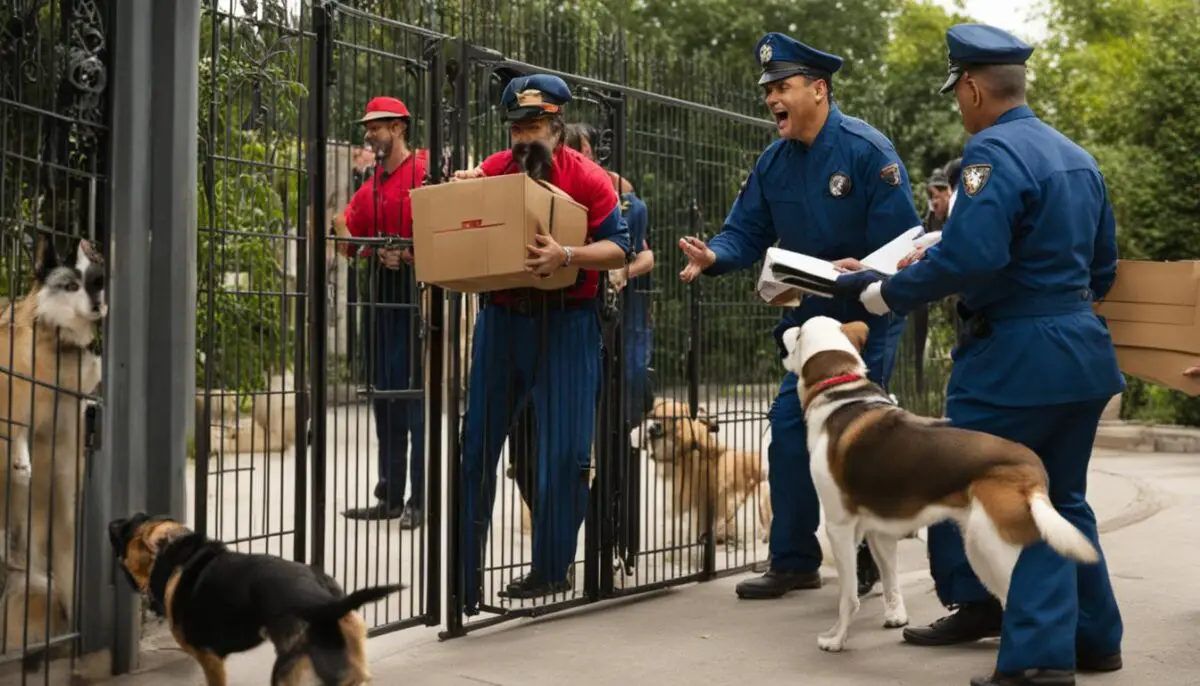
To better understand the impact of body language and behavior on a dog’s reaction to mailmen, let’s take a look at the following table:
| Body Language/Behavior | Dog’s Reaction |
|---|---|
| Confident and relaxed posture | May be less likely to trigger a dog’s defensive response. |
| Quick and jerky movements | Can heighten a dog’s agitation, potentially leading to aggressive behavior. |
| Use of equipment (e.g., mailbags, scanners) | May be interpreted as threatening by dogs, intensifying their response. |
Understanding the impact of body language and behavior can help mail carriers and dog owners alike. By adopting calm and non-threatening postures, mailmen can reduce the likelihood of inciting a negative reaction from dogs. Similarly, dog owners can work on desensitizing their pets through positive reinforcement training to help them associate mailmen with positive experiences rather than threat.
Lack of Proper Socialization and Training
Dogs that haven’t received proper socialization and training may be more likely to exhibit aggressive or fearful behavior towards mail carriers. Training them to remain calm, follow commands, and positively associate with strangers can help prevent aggression towards mail carriers.
Proper socialization plays a crucial role in shaping a dog’s behavior and reactions towards various stimuli, including mail carriers. When dogs are not exposed to different people, situations, and environments during their early development stages, they may become fearful or anxious around new individuals, such as mail carriers.
It’s essential to introduce your dog to a wide range of people, including those who wear uniforms or carry bags, to familiarize them with such appearances and prevent any negative associations.
Training your dog to remain calm and obedient in the presence of mail carriers can significantly reduce their aggression or fear towards them. Teaching commands like “sit,” “stay,” or “heel” can help redirect your dog’s attention and prevent unwanted reactions.
Positive Reinforcement Techniques
Using positive reinforcement techniques can be highly effective in preventing aggression towards mail carriers. By rewarding your dog with treats, praise, and affection when they exhibit calm behavior around mailmen, you can reinforce positive associations and gradually change their perception of these individuals.
“Good boy, Max! Look, it’s the mailman! Sit calmly and receive a treat!”
“Proper socialization and training play a crucial role in preventing dog aggression towards mail carriers. By exposing them to different people and situations and teaching them obedience commands, owners can help their dogs develop a positive association with mailmen.”
Remember that prevention is key in managing your dog’s aggression towards mail carriers. Investing time and effort in their socialization and training from an early age can significantly decrease the likelihood of hostile behavior.
| Training Tips | Description |
|---|---|
| Positive Reinforcement | Use treats, praise, and affection to reward calm behavior around mail carriers. |
| Desensitization | Gradually expose your dog to mail carriers while providing positive experiences, such as playtime or treats. |
| Counter-Conditioning | Create positive associations by pairing the presence of mail carriers with rewards, such as treats or favorite toys. |
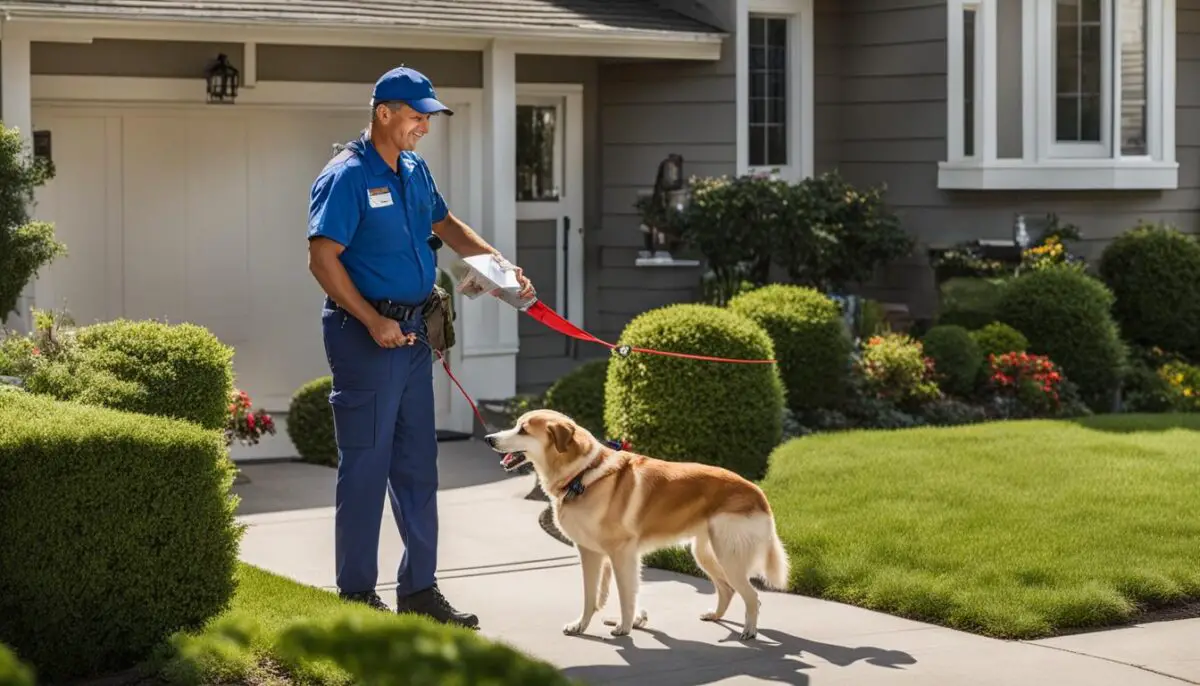
By implementing these strategies consistently and patiently, you can help your dog overcome their dislike towards mailmen and create a harmonious environment for both your pet and the postal workers who visit your home.
Manage Dog’s Fear and Aggression towards Mailmen
Dealing with a dog’s fear and aggression towards mailmen can be challenging, but with the right techniques, it is possible to change their negative associations and create a more positive response. Two effective methods for managing a dog’s fear and aggression towards mail carriers are desensitization and counter-conditioning. These techniques involve gradually exposing the dog to the presence of mailmen in a controlled and positive manner.
Desensitization aims to reduce the dog’s emotional response by gradually increasing their exposure to the stimulus that triggers fear or aggression. In this case, it involves exposing the dog to the sight and sound of mail carriers from a distance. This can be done by taking walks or sitting in a calm area where the dog can observe mailmen from afar. It is crucial to maintain a safe distance to prevent the dog from becoming overwhelmed or reactive.
Counter-conditioning focuses on changing the dog’s emotional response from negative to positive. By associating the presence of mailmen with something pleasant, such as treats or praise, the dog can learn to view mailmen in a more positive light. Start by rewarding the dog with treats and praise every time they see a mailman. Gradually, as the dog becomes more comfortable, increase the proximity and continue rewarding their calm behavior.
Consistency and patience are key when using these techniques. It is essential to progress at a pace that the dog is comfortable with, ensuring their fear and aggression do not escalate. Gradually decrease the distance between the dog and the mailman over time, always monitoring their response and adjusting accordingly. With consistent practice and positive reinforcement, the dog can learn to associate mail carriers with positive experiences and reduce their fear and aggression.
“Desensitization and counter-conditioning are powerful tools for managing a dog’s fear and aggression towards mailmen. By gradually exposing the dog to mail carriers and associating their presence with positive experiences, we can help change their negative associations and create a calmer response.”
Remember, it is crucial to consult with a professional dog trainer or behaviorist before implementing these techniques to ensure they are suitable for your dog’s specific needs. They can provide guidance and support throughout the process, helping you address your dog’s fear and aggression towards mail carriers effectively.
Tips for Successful Desensitization and Counter-Conditioning:
- Start at a distance where the dog feels comfortable and calm.
- Gradually decrease the distance over time, ensuring the dog remains calm and relaxed.
- Associate the presence of mail carriers with positive rewards, such as treats and praise.
- Avoid punishment or forcing the dog to interact with mailmen, as it can worsen their fear and aggression.
- Practice regularly and be consistent with the training sessions.
By implementing desensitization and counter-conditioning techniques, you can help your dog overcome their fear and aggression towards mailmen, creating a safer and more peaceful environment for both your pet and the mail carriers.
| Benefits of Managing Dog’s Fear and Aggression towards Mailmen | Techniques Used |
|---|---|
| Reduces stress for the dog | Desensitization |
| Creates a safer environment for mail carriers | Counter-conditioning |
| Improves the dog’s overall behavior and socialization | Treats and praise |
Conclusion
Dogs’ dislike towards mailmen can stem from a combination of factors. Their instinct to protect their territory and pack members can trigger a fear or aggression response when mail carriers approach. Negative experiences with mailmen, such as feeling threatened or startled in the past, can also contribute to their aversion.
Lack of familiarity and socialization with mail carriers can further fuel a dog’s negative reaction. Dogs may perceive mailmen as strangers invading their territory, leading to a defensive response. Additionally, dogs are highly attuned to human body language and behavior, and certain aspects of a mailman’s appearance or movements can trigger a dog’s prey drive, fear, or territorial instincts.
Proper socialization and training are crucial in preventing dog aggression towards mail carriers. By exposing dogs to positive interactions with strangers, teaching them to remain calm and follow commands, and gradually desensitizing them to the presence of mailmen, owners can help change their negative associations and create a safer environment for both their pets and mail carriers.
FAQ
Why do dogs hate mailmen?
Dogs often display aggression or fear towards mailmen due to their natural instinct to protect their territory and pack members.
What causes a dog’s negative reaction to mail carriers?
Dogs may have had negative experiences with mailmen, leading to a lasting aversion. Lack of familiarity, proper socialization, and understanding of body language can also contribute.
How can I prevent my dog’s aggression towards mail carriers?
Proper training, desensitization, and counter-conditioning techniques can help manage a dog’s fear and aggression towards mailmen. Creating positive associations and exposing them gradually can make a difference.
Why are dogs wary of unfamiliar individuals like mailmen?
Dogs are naturally cautious of strangers entering their territory, and the appearance and fast movements of mailmen can trigger fear or territorial responses.
How does lack of socialization contribute to a dog’s aggression towards mail carriers?
Dogs that haven’t been properly socialized may be more likely to exhibit aggressive or fearful behavior towards mail carriers. Training them to positively associate with strangers can help prevent aggression.
What role does instinct play in a dog’s dislike towards mailmen?
Dogs have a natural instinct to protect their territory and pack members. When mail carriers approach, dogs may perceive them as potential threats, triggering fear or aggression.
What can I do to manage my dog’s fear and aggression towards mailmen?
Techniques such as desensitization and counter-conditioning, accompanied by rewards and praise, can help change a dog’s negative associations with mailmen. Gradual exposure in a controlled manner is key.
